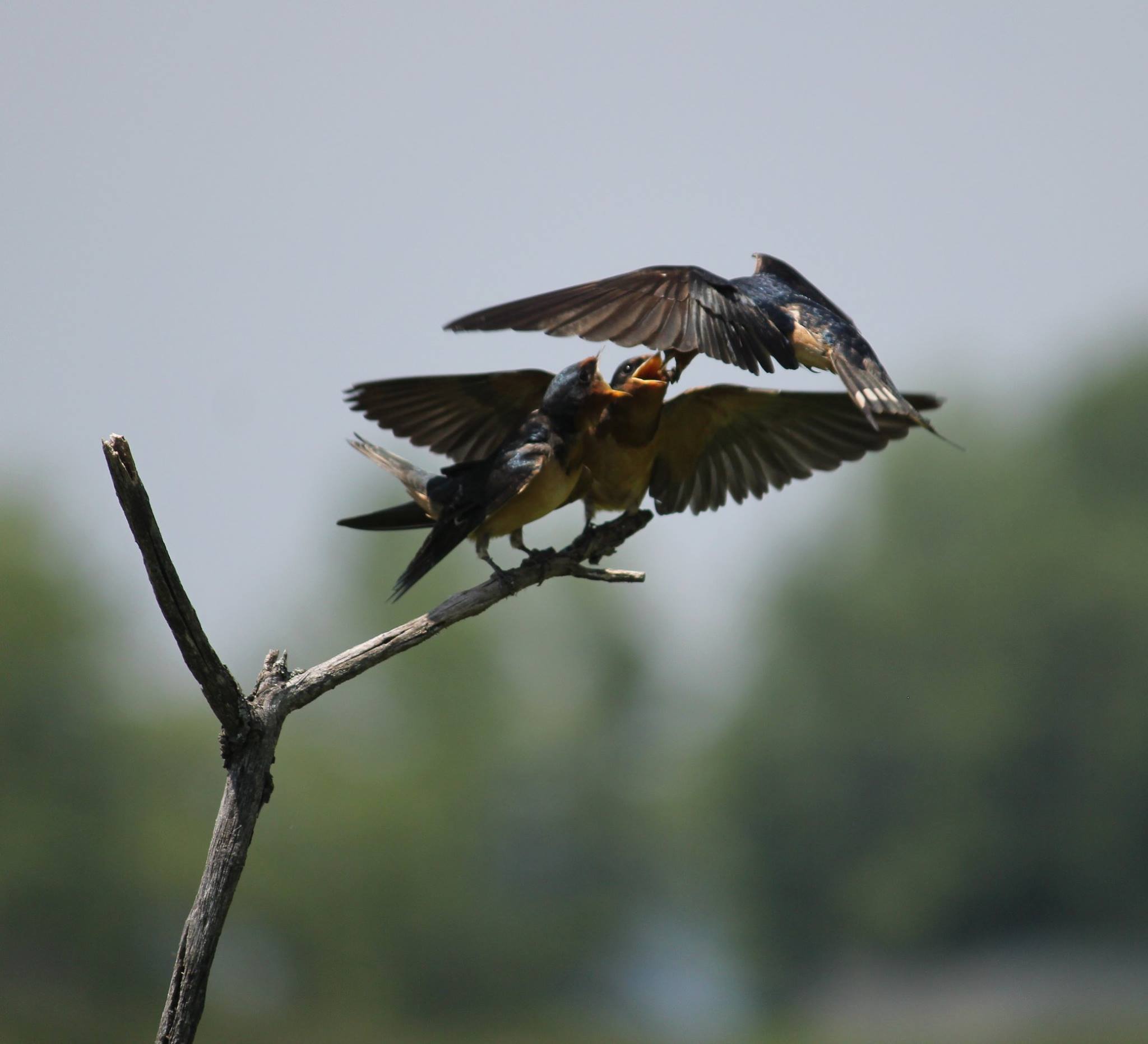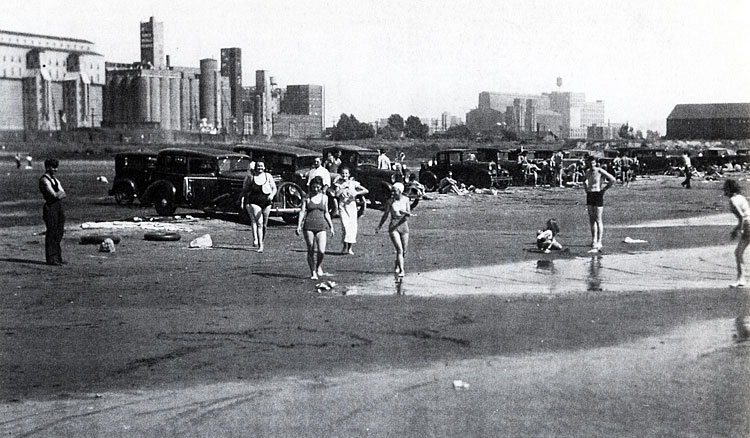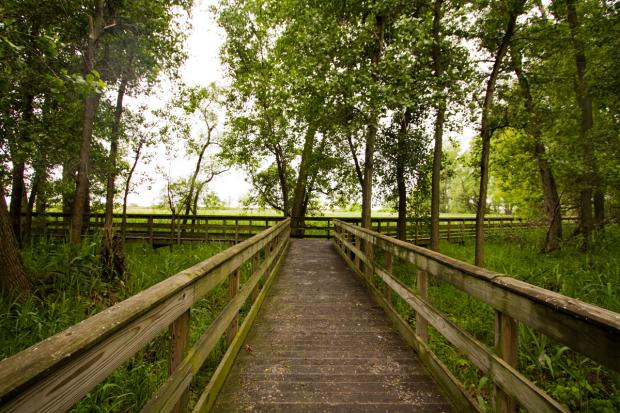Times Beach Flowers Anew
There’s a stand of common milkweed on a narrow strip of Times Beach Nature Preserve on Buffalo’s Outer Harbor that gets The Public’s environment and ecology editor beaming. The plant’s name doesn’t deceive; it’s found on disturbed soils and along roadsides pretty much everywhere. What makes this particular clump of milkweed so special to Jay Burney is that up until last year, there wasn’t any. It started with five plants and has ballooned to a hundred. Upon lazy inspection wildlife was abundant among the milkweed: Snails clung to leaves, a milkweed beetle scouted up a stalk, honeybees and bumble bees feed on nectar, grasshoppers bounced from leaf to leaf, and five species of butterflies hovered above them.
In years past the entire area was given over to the invasive Japanese knotweed, a monster of an ornamental flower that has colonized riparian areas along the area’s waterways. “In years past, I’d see one or two monarch butterflies in fall migration, feeding on a knotweed flower. They’re tiny, hardly any nectar. And besides that, no butterflies at all,” Burney said. “There’d be dead butterflies everywhere.”
Those days seem long gone, thanks to a $5 million investment from the US Army Corps of Engineers to help rid Times Beach of its knotweed, phragmites, and buckthorn pests. The results are stunning. The knotweed was all injected with a herbicide, and another Round Up-type chemical was used on the phragmites reeds. Now native cattails have returned to the marsh, Where the knotweed was is a who’s-who of powerful colonizers sharing space: mullein, catnip, Queen Anne’s lace, daisy, mugwort, teasel, and tons of Canada and bull thistle.
But hidden in the mix a lone strand of Japanese knotweed snaked out from the brush, serving as a cruel reminder of the stubborn tenacity of life, otherwise known as the naturalist’s headache, the preservationist’s dilemma, or simply the history of Times Beach.
Times Beach wasn’t always this way. In fact, it wasn’t always even there. It was very briefly a public beach in the 1930s before being closed due to the unsurprising hazards of sewage runoff and industrial contamination. In the 1950s the US Army Corps of Engineers constructed a containment dike and dumped sediment dredged from the Buffalo River and the harbor, creating an ersatz wetland and multiple acres of new terra firma surrounding a pool of lake water. By a combination of accident, neglect, and dedication from groups like the Friends of Times Beach Nature Preserve, the area is a wildlife sanctuary that has seen 248 species of birds over the years.
It’s a strange situation to ponder: Once, Burney says, marsh and wetlands dominated the shoreline from the Hamburg cliffs to Lake Ontario. Early 19th-century maps show evidence of Lake Tonawanda, a sprawling shallow wetland that stretched from North Tonawanda into Monroe County, large sections of which still exist as the Iroquois National Wildlife Refuge. All of that area was teeming with wildlife. Now groups are striving to protect nature preserves that have sprung up on reclaimed wetlands, including Times Beach’s neighbor, Tifft Nature Preserve, to give wildlife an enduring footprint in the Buffalo Harbor.
As Burney tends to freshly planted butterfly weed, he describes how during migration Times Beach is the last or first place butterflies and birds stop before or after crossing the expansive Lake Erie, and pointed to newly marked “pollinator conservation” areas along the path. “We’d like to create a pollinator corridor throughout the Outer Harbor, and even beyond that, really, ” Burney said.
As the stretch of milkweed shows, the plan to increase Times Beach’s potential as wildlife habitat and food and water source is substantial. Still, it’s not all success stories. “Ten years ago, we had bullfrogs and even some salamanders. Now there are really no amphibians. Big rat snakes, but no amphibians.” Continental trends of bee colony and bat population decline are also felt in the preserve.

Photo by Jay Burney
Along the way, we came across two juvenile barn swallows, accepting free lunch from their parent, mouths open wide. Another birder, Shelley Seidman, paused to watch as the parent swallow kept circling back with fresh kill. Seidman praised the work Times Beach and its neighbors are doing on the Outer Harbor. A downtown resident without a car, she has been commuting to the preserve on the bike ferry from Canalside, which drops passengers directly across from the preserve. “I really don’t know what I’m going to do after Labor Day [when ferry operations cease],” she said.
While the entire Outer Harbor has seen tremendous recent change, there’s still more transformation on the horizon. At one point, the Erie Canal Harbor Development Corporation, the public entity that was gifted the NFTA expansive holdings in the area, was planning to ring Times Beach with high-rise residential buildings, an idea that still makes Burney bristle in his extraordinarily even-mannered way. “This is a nature preserve,” he said. “If you bring city life closer, we’ll lose it.” The ECHDC has backed down from the plan, but it’s inevitable that some mixture of residential and further recreational and entertainment facilities will be proposed. Burney would just like to see a commitment from public development that complements what’s already working on the Outer Harbor.

From Times Beach’s short-lived period as a public swimming site.
Photo courtesy of Friends of Times Beach Nature Preserve by way of the Buffalo History Museum.
Friends of Times Beach has been going strong for more than 20 years, achieved status for the site as a nature preserve in the early 2000s, and is currently developing a master plan for the site’s future that can incorporate purposes of wildlife preservation and public access. And it’s a private/public partnership between the Friends of Times Beach and various governmental entities. The city owns the land, but the county lends a hand to maintain it. Burney praises the partners that have helped create this nature preserve on Buffalo’s outer harbor. ”This has been a project sponsored by a collaboration between the Corps of Engineers, the city, and Erie County, who have been terrific stewards of this place.”
After 20 years, Burney, who has been a videographer for the Buffalo Bisons for more than a decade, measures his passion for the preserve against the unpredictable forces of man and nature. Before the fill covered the shore, a shantytown existed along what is now Fuhrmann Boulevard that would often get destroyed by the heave-ho of Lake Erie’s temper. In 200 years, the Times Beach site is an open book unto American history. Read it often enough, and it imparts a few lessons. Out of nowhere, the mild-mannered Burney said he wasn’t going to die for the preserve. He’ll do his best to accept whatever the future brings. “I’m not going to get arrested or anything like that—I don’t think.”

